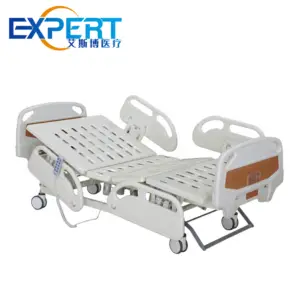Dirección
304 North Cardinal St.
Dorchester Center, MA 02124
Horas laborales
Lunes a viernes: 7:00 a. M. - 7:00 p. M.
Fin de semana: 10 a. M. - 5 p. M.
Antes de profundizar en el contenido, me encantaría que te unas a mí en mis plataformas de redes sociales, donde comparto más información, interactúo con la comunidad y publico actualizaciones. Puedes conectarte conmigo de la siguiente manera:
Facebook:https://www.facebook.com/profile.php?id=100071234835011
LinkedIn:https://www.linkedin.com/company/74943205/admin/dashboard/
YouTube:www.youtube.com/@shandongexpertmedicalequip4695
TikTok:www.tiktok.com/@expertmedical
Ahora, comencemos nuestro viaje juntos. Espero que el contenido que se incluye aquí te resulte interesante, interesante y valioso.

Hospital table beds, also known as medical examination tables or treatment tables, are essential pieces of equipment in healthcare facilities. These versatile tables serve a multitude of purposes, from patient examinations and treatments to minor surgeries. Designed with both patient comfort and medical functionality in mind, hospital table beds come in various sizes, styles, and configurations to accommodate a wide range of medical procedures.
In this comprehensive guide, we will delve into the key features and benefits of hospital beds. We will explore the different types available, the materials used in their construction, and the safety standards they must adhere to. By the end of this article, you will have a thorough understanding of why hospital beds are an indispensable asset in any healthcare setting.
Hospital table beds play a crucial role in providing efficient and effective healthcare. They offer a stable and adjustable surface for medical professionals to perform a variety of procedures, including:









Altura ajustable: One of the most important features of a hospital bed is its ability to adjust in height. This allows medical professionals to position the table at a comfortable working height, reducing strain and fatigue.
Variable Positions: Hospital table beds offer a range of positions, including Trendelenburg, reverse Trendelenburg, and Fowler’s positions. These positions are essential for various medical procedures and can help to improve patient comfort.
Construcción robusta: Hospital beds are constructed from durable materials, such as stainless steel and high-density plastic. This ensures that they can withstand heavy loads and frequent use.
Easy to Clean and Disinfect: The surfaces of hospital table beds must be easy to clean and disinfect to prevent the spread of infections. Most hospital beds have smooth, seamless surfaces that are resistant to bacteria and viruses.
Caracteristicas de seguridad: Hospital beds are equipped with safety features, such as side rails and non-slip surfaces, to prevent patients from falling or sliding.
Hospital table beds come in a variety of styles and configurations to meet the specific needs of different medical facilities. Some common types include:
| Característica | Descripción |
|---|---|
| Altura ajustable | Allows for ergonomic positioning for medical professionals. |
| Variable Positions | Offers a range of positions like Trendelenburg and Fowler’s for various procedures. |
| Construcción robusta | Ensures durability and stability for heavy loads and frequent use. |
| Fácil de limpiar y desinfectar | Smooth, seamless surfaces resist bacteria and viruses. |
| Caracteristicas de seguridad | Includes side rails and non-slip surfaces to prevent accidents. |
The materials used in the construction of hospital beds must be durable, easy to clean, and resistant to chemicals and disinfectants. Common materials include:
Hospital table beds must comply with strict safety standards to ensure the safety of both patients and medical professionals. These standards cover a range of factors, including:

Hospital table beds are an essential piece of equipment in any healthcare facility. They provide a stable and adjustable surface for medical procedures, enhancing patient comfort and safety. By understanding the features and benefits of hospital table beds, healthcare professionals can make informed decisions when selecting the right equipment for their facility.
What is the difference between a hospital bed and a hospital table bed?
A hospital bed is designed for patient rest and recovery, while a hospital table bed is specifically designed for medical procedures and examinations.
How often should hospital beds be cleaned and disinfected?
Hospital beds should be cleaned and disinfected after every use to prevent the spread of infection.
What are the most important safety features to look for in a hospital table bed?
Key safety features include adjustable height, non-slip surfaces, sturdy construction, and easy-to-clean materials.
How do I choose the right hospital bed for my facility?
Consider factors such as the types of procedures performed, patient capacity, and budget when selecting a hospital bed. Consult with medical professionals to determine the best fit for your specific needs.
